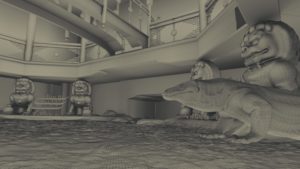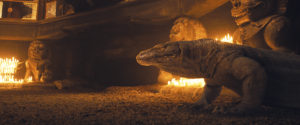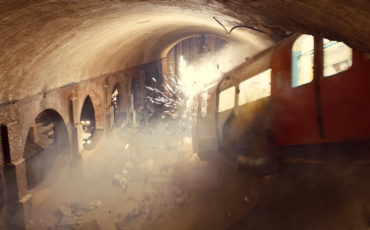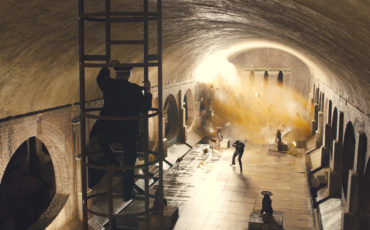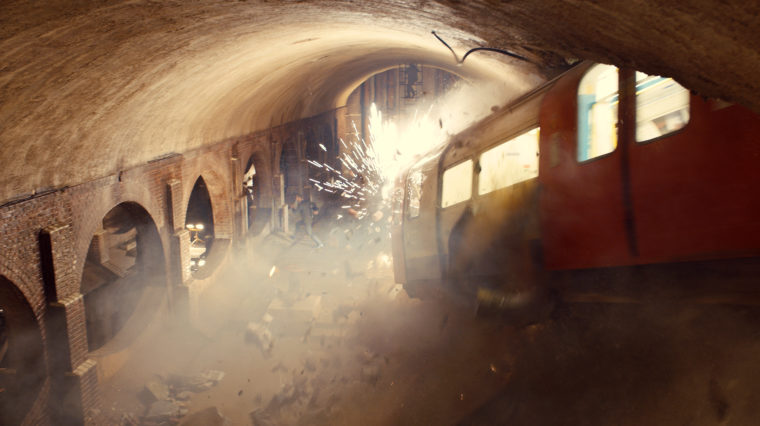
CGSociety: Skyfall
In case you’ve been under a rock, Skyfall is the latest James Bond franchise adventure movie, the 23rd excursion for the Ian Fleming stories. A long list of VFX studios were given rope on the production, including Cinesite, MPC, DNeg and Framestore. Thankfully, the Bond series are not being created in stereo, I’m assuming that it would distract from the more stayed, old-world British aura around the stories. This is however, the very first time a fully CG creature has been employed in the Bond film franchise. Being a replacement for a real creature, the komodo dragon had to be convincingly real at full screen. There were three sequences in particular taken on by Cinesite where the facility used its digital environment expertise to enhance physical stunts and effects for the Skyfall movie.
Charing Cross
Without giving too much away to begin with, the London-based Cinesite worked on an initial chase sequence set in London’s Charing Cross Station. Gymnastics were required, but only enough by the actors to show them in situ.
Bond chases the villian who dresses as a member of Police, and they go onto the Underground and both slide down the middle panels of the escalator. They get to the bottom and they carry on. “While it looks like a bit of fun on set, it turns into a thoroughly believable stunt with rig removal,” explains Jon Neill, Cinesite’s VFX Supervisor on Skyfall. “We had to rebuild the bottom of the escalator, because on set they had created this huge chute so the actors wouldn’t hurt themselves on any sharp bits. So we had to go in and put all that floor back in the footage.”
All of this sequence was set on Charing Cross Station in London. At Pinewood Studio, they built half a train so Daniel Craig could jump onto the back on it, as directed by Q over the earpiece in the story. When the two leads run onto the platform, Craig does the actual jump, but there was a trailer underneath in case he missed and fell. All of that had to be painted out and replaced with the normal tracks and such, including a cameraman and focus puller,” he continues. “All of the background of the station; passengers on the train and Charing Cross infrastructure had then to be inserted to complete the visuals.”
This escalator slide sequence was tricky because there was a lot of roto and clean-up. “We took 360-degree photogrammetry of a real ‘bottom of an escalator’, created a mesh of it, brought that into NUKE and rebuilt the surroundings that way,” Neill explains. “Projecting the image onto a mesh in NUKE was fairly easy in that sense.” There was a crash mat that was the same color of the floor, but it still had to be the replaced with the floor. “To extend the platform, we used extensive HDRI images of Charing Cross and shot the sequence at Pinewood, mapping onto the mesh as we needed,” Neill explains.
Komodo
This is the first Bond film to feature a CG creature. “It had to be photo-real for Bond,” says Jon Niell, “and they couldn’t have a komodo dragon on set obviously.” In Skyfall, there is a Komodo Dragon pit [in the casino, as any self respecting casino would have…]. In pursuit of his attacker, Bond [James Bond] has travelled from London to a floating casino in Macau, and of course both of them fall into the pit and fight among the Dragon. This is where the Cinesite artists come into the story. They built a complete CG komodo dragon, placed it in the pit and lit it in broad daylight, because, “if it was believable in broad daylight, it could be totally believable in dramatic lighting which was required for the sequence in the casino,” adds Neill. “Then they cranked down the shutter to allow the candlelgiht in the pit to take over, giving an even more believeable glow to the surroundings.
Neill reveals that Cinesite has their own inhouse photographer and they had access to two komodos at the London Zoo. They were able to get right up close to the komodos, as there was a special room where the artists could set up lights and get some really close-up high resolution texture images of the skin of the komodo for reference. Eyes, teeth, flaky skin and mouth. Using this truly reference material, Cinesite’s character animation team modeled the creature in Maya and textured it using Mudbox and Mari, before compositing it into the live-action plate using Nuke. “One of the komodos was ‘friendlier’ because it was hand-reared and the keeper was in the room with it,” adds Neill. “That dragon was great for textures, but there was another one, younger and feistier. We used that one to study the movement with three synched video cameras, as it jumped around catching mice and anything else it wanted.”
The Cinesite modeler Graham Curtis built the komodo dragon model all in Maya with a dense mesh so the texture could be mapped onto it, with lighting and several other passes added on. The model was actually so dense, they had to break it up into smaller sections. CG dust and gravel that mirrored the action within the dragon’s pit were also added, while the lighting and shading had to be carefully angled to ensure the correct depth of field.
The catacomb sequence was staged on the massive ‘007’ set at Pinewood, with a extensive special effect stunt planned. Everything was done at life size, the three carriage train was life-size, and whole brick and masonry building was real and there was a rail system which would fly the train through the ceiling of the catacombs. The sewer which ran below the track was much akin to Victorian brickwork with archways. There was a main room but through the archways, a great deal of CG perspective had to be filled in by Cinesite.
“We build a 3D model of the archways we knew we’d require, and took a massive texture shoot of the brickwork we also knew we needed,” says Neill. “Using the NUKE pipeline, we projected it onto the model again and then set that into the black areas, to fill the perspective.”
In the studio, after the train ran through and fell into the lower level, there were cables and brackets holding the physical train up. These also had to be matted out and replaced. NUKE helped the crew here as well, as the ceiling was all mapped and ready to be replaced. The brackets and cables left a signature sweep in the air as well, and this had to be corrected. To enhance the look, Cinesite’s team created a digital set extension to expand the arches in the catacomb and give it a greater sense of depth. They also digitally removed the camera crew that was positioned in front of Bond as the train comes crashing down, as well as the rig the train was suspended on, and enhanced the practical dust and debris with 3D particles. There were also ten or so Arri cameras on set as well, all of which had to be painted out.
Making this sequence that much harder again was the fact the James Bond character was in the foreground of the wide shot, which made the replacement of Bond’s legs with CG legs a necessity. Rotoscoping was the solution. “It was straight forward enough,” says Neill. “Because there were ten cameras, there was no place to attach any green screening, so it has to be a digital double for the crash shot. Roger Deakin, the DP, wasn’t a fan of green screening anyway, because it contaminates the lighting.”

